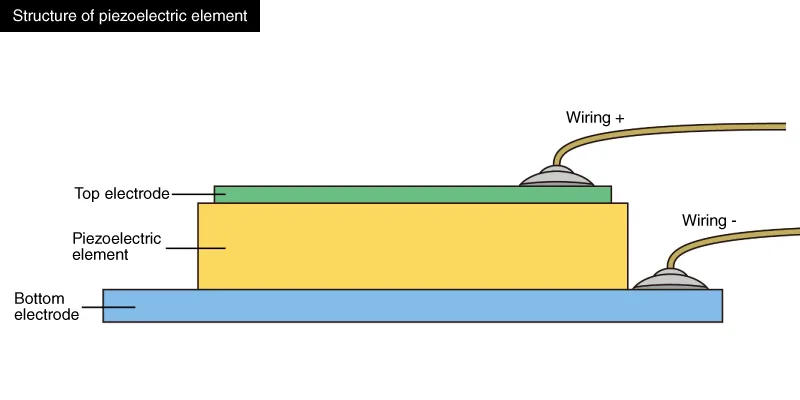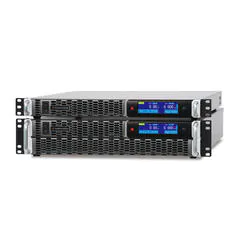
About Piezoelectric Devices
The piezoelectric effect is a phenomenon that occurs primarily in dielectric materials, such as quartz and tourmaline, wherein an electric charge is produced owing to a voltage being generated when pressure is applied. Conversely, when voltage is applied to these dielectrics, they change dimensions (reverse piezoelectric effect), i.e., they expand or shrink. Passive devices that utilize the piezoelectric effect are called "piezoelectric devices".
Dielectrics that can observe the piezoelectric effect have an asymmetrical lattice-like crystal structure. As a result, the centers of positive and negative charges are unevenly distributed, and polarization is constantly occurring within the crystal.
Under normal conditions, the crystal adsorbs ions from the air, neutralizing the charge on the crystal surface so that no voltage is generated. However, voltage is generated when the crystal is deformed by external mechanical pressure, the bias between positive and negative charges is displaced, and the state of polarization changes.
This is known as dielectric (electric) polarization, and material that exhibits this phenomenon is referred to as piezoelectric.
The piezoelectric effect was discovered in 1880 by Pierre Curie, a Nobel laureate in physics, and his brother Jacques Curie. A well-known example that utilizes the piezoelectric effect is the ignition device for gas stoves and lighters.
In ignition devices that use piezoelectric material, when the switch is pressed, the parts inside the switch strike the piezoelectric element with a "click" sound. The voltage generated by this pressure creates a spark, which ignites the gas.
The reverse piezoelectric effect is also used in inkjet printers, SLR autofocus, and image stabilization.
Such devices are also called "piezoelectric devices," derived from the Greek word "piezein", meaning "to apply pressure."
Structure of piezoelectric devices
Piezoelectric devices have a simple structure comprising a piezoelectric material sandwiched between electrodes. The advantage of this structure is that it is strong and lightweight.

Ferroelectric ceramics are made by baking the material at high temperatures and then applying a strong electric field of several kV/mm. By utilizing the piezoelectric effect, piezoelectric elements can be used as ignition devices, as well as vibration and pressure sensors.
Additionally, the reverse piezoelectric effect allows physical motion to be obtained by simply applying a voltage, eliminating the need for mechanical components such as motors or gears. It exhibits a quick response and can control smooth and precise movements of less than one micron. It is also easy to miniaturize, making it an excellent component for precision machinery.
However, the range that can be moved by a single element is narrow, which is only a few tens of microns. For applications that require a larger variation, a stacked type is used.
Applications of the piezoelectric effect
Piezoelectric elements are used in a variety of products other than the aforementioned gas stoves and lighters. For example, facilities have been installed in many places where the vibration and weight of a walking person can be converted into electricity via piezoelectric elements and used for night-time lighting and the opening and closing of doors.
Moreover, as piezoelectric elements are small and can be precisely controlled, they are often used as components in high-precision equipment.
- Vibration sensors
- These sensors utilize the piezoelectric effect. Here, a weight is attached to the piezoelectric element, and the force generated by the vibration is converted into a voltage for detection. They are characterized by their small size and relatively low cost. They are used in industrial applications as well as medical applications, such as heart rate sensors.
- Piezoelectric speaker
- Using the inverse piezoelectric effect, piezoelectric materials can be used as the source of vibration for speakers. A plate-shaped piezoelectric element is attached to a metal plate; when a signal is sent to the piezoelectric element, the expansion and contraction of the piezoelectric element cause the metal plate to vibrate, thereby generating sound. These speakers are lightweight and consume little power.
- Inkjet printers
- Similar to piezoelectric speakers, the ink ejection mechanism of inkjet printers consists of a piezoelectric element bonded to a metal plate, which is deflected by the deformation of the piezoelectric element to eject the ink. The amount of ink can be precisely controlled, and printing at a high speed can be accomplished.
- Piezo driver
- A piezo driver is required to drive the piezoelectric element. Piezoelectric elements have capacitance, so they bounce back input signals under certain conditions. Therefore, a normal DC is not enough to drive the piezoelectric element optimally. A power supply that can both source and sink current is needed. A piezo driver is a high-voltage amplifier-type power supply that can stably drive a piezoelectric element based on its purpose.
- Actuator
- An actuator is a device that converts electrical energy into mechanical energy. Piezoelectric devices are used as actuators in a variety of situations because they can convert electrical energy into mechanical energy via the inverse piezoelectric effect.
Actuators using piezoelectric elements have the following advantages
- Fast response time
- Smooth movement
- Precise movement within a few microns is possible
- High load capacity
- High durability
Piezoelectric actuators are also used in bases that support the primary mirror of large astronomical telescopes used for observing the universe. As the mirror of an astronomical telescope can be as large as 8 meters in diameter, deformation due to its own weight is unavoidable. Therefore, the backside of the mirror is supported by the actuator to correct the distortion of the mirror surface.
Actuators using piezoelectric elements are used not only in cutting-edge science such as in astronomical telescopes but also in familiar applications such as smartphones, especially in touchscreen panels where only fingers are used.
Piezo actuators are also used in semiconductor lithography equipment to expose electronic circuit patterns on silicon plates and optical measuring instruments used in manufacturing and research laboratories to fine-tune the positioning of mirrors, just as in astronomical telescopes.
They are also used for image stabilization in digital cameras. When one attempts to take a picture with a camera, the movement of the hand to press the shutter or the minute movements of the body would cause the camera to shake. Image stabilization is used to quickly move the light-receiving part of the camera based on the magnitude of the blur. Piezoelectric actuators are also suitable in this regard given the requirement to move accurately with an extremely fast response time.
Related Technical Articles
Recommended products
Matsusada Precision provides precision control solutions with piezo actuators and piezo drivers.






